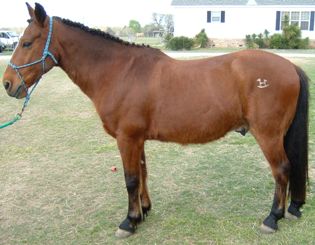Site Menu:
| This is an archived Horseadvice.com Discussion. The parent article and menus are available on the navigation menu below: |
| HorseAdvice.com » Diseases of Horses » Endocrine System » Pituitary Pars Intermedia Dysfunction (PPID): Equine Cushing's » |
| Discussion on Slow to shed winter coat | |
| Author | Message |
| Member: shanson |
Posted on Tuesday, Aug 11, 2009 - 9:11 am: Hi DrO,Would like your thoughts on my approx. 13-year-old mustang/Peruvian paso cross. I’ve owned him for about 6 years and knew him before that. He’s always had a very long winter coat, which shed out fine in the spring and was no big deal. This year, though, he was slow to shed and still has a bit longer summer coat than usual. We also noticed small fat deposits at tailhead and he’s always had a slight tendency to a pot belly. Otherwise, he seems fine: a medium keeper in good weight; reasonably fit and in regular use; great feet. Never had any weight or laminitis issues. Generally, a very tough and healthy guy. I took him to local vet hospital and had fecal and Cushings tests run. Vet immediately suspected Cushings from visual inspection. Tests didn’t confirm this, though: • Fecal: negative (he’s been on a very good worming program, confirmed by fecals, as long as I’ve had him) • Endogenous ACTH Levels: high normal • Dexamethasone Suppression Test (DST): normal Based on these results, vet recommends continuing my current management, which is free-choice grass hay, low starch/sugar feed, and plenty of exercise. I feed Acco Safe and Sound; when I asked her about feed, she suggested I consider something like Purina LS. She also recommends a yearly Cushings test. This is all fine with me, but the slow-shedding coat puzzles me. Can a horse test negative, but be in very early stages of Cushings? Pix below of him in March when he was about half-way shed out. We had clipped his chin whiskers & hair on underside of neck. Thanks! ...sharon 
|
| Moderator: DrO |
Posted on Wednesday, Aug 12, 2009 - 6:33 am: Hello Sharon,I concur with your veterinarians plan. As for how specific and sensitive the various testing methods are in the horse this is covered in detail in the article. DrO |
| Member: shanson |
Posted on Wednesday, Aug 12, 2009 - 8:34 am: Oh, I see now that I had not read the article closely enough, and that it clearly answers my question. Thanks! |
| Member: snyderpm |
Posted on Wednesday, Oct 7, 2009 - 10:41 pm: I have spent thousands and thousands of dollars on my Thoroughbred horse, who I guess has Cushings and for sure is Insulin resistant. My horse is only eleven years old, and I have been having known trouble with him since he was six years old. He has had many episodes of laminitis, and his hair is very long and thick and shaggy early in the fall, and does not shed out in the summer. I live in the deep south, so there is no reason for hair. I have spent thousands, and thousands of dollars with dim whit vets, who know nothing about what they are talking about. Just recently, I had to drag my female vet into my horses stall to look at my horse's hair. Look at his hair, I said. Remember, you were too busy the last time you were here, giving falls shots, and had to get to your latest boyfriend, so screw my horse. Although, she was the one who told me I should decrease his Pergolide, because she said that Dr. Kellon said, " that he is too young to have Cushings". Hello, he has 2 inches of hair in August, living in the deep south. What am I missing. I would like to hear you response , DR. O, being that I am also feeding your lair. |
| Moderator: DrO |
Posted on Thursday, Oct 8, 2009 - 6:17 am: Hello Patricia,You seem to be missing several things here. While I appreciate that you help feed my children, you are missing that communication in Horseadvice needs to be kept civil and polite. There is a unpleasant edginess to your post and if you would like a refund and termination of your membership please let me know. You are also missing that we ask that you post questions about your own horse in your own discussion by starting a new discussion. Back up one page from this discussion using the navigation bar at the top of this page and if you have not already studied the article on "Cushings in Horses" this would be a good time. If after studying it you still have unanswered questions the new discussion button is at the bottom of the article page under the list of already started discussions. I will be glad to try and answer your questions and work you through to a solution to your horse's problem but I can be most helpful when you formulate specific questions you have. DrO |
Horseadvice.com
is The Horseman's Advisor
Helping Thousands of Equestrians, Farriers, and Veterinarians Every Day
All rights reserved, © 1997 -
is The Horseman's Advisor
Helping Thousands of Equestrians, Farriers, and Veterinarians Every Day
All rights reserved, © 1997 -
